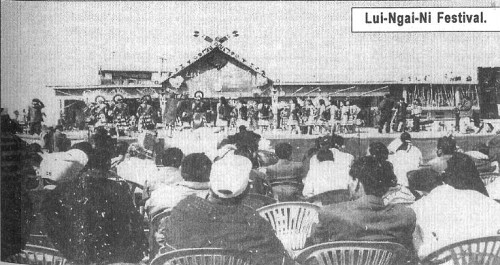Lui-Ngai-Ni
( The Naga Seed Sowing Festival )
By: N Mangi Devi *
A people, big or small has a culture, a way of life, and a philosophy by which they live, thrive and cope with; and the phenomenal cultural diversity of Nagas lends colour to their collective identity. In all there are about forty odd tribes that constitute the Naga society in Manipur and out of these Chiru, Chothe, Kharam, Lamkang, Mao, Maram, Maring, Monsang, Moyon, Poumai, Tarao, Tangkhul, Thangal, Impui and Zeliangrong tribes could be mentioned.
Like many tribals of the North East India, the Nagas have rich and colourful culture. Every Naga tribe celebrates every important event of their life with festival, and Lui-Ngai-Ni is the festival of festivals celebrated during the season of spring signifying the sowing of seeds.
The word LUI-NGAI-NI is derived from three naga tribal words. Namely, Tangkhul, Rongmei and Mao/ Poumei, in Tangkhul dialect is derived from the word, Luira/ Luita which means seed sowing festival. NGAI is a Rongmei word which means festival and is derived from the word Gan-Ngai and NI is a Mao/Poumei word which means festival. So, LUI-NGAI-NI is a conglomeration of Tangkhul, Rongmei and Mao/Poumei dialect.
During this festival, the gods of crops are invoked to shower their blessings on the seeds sown so that they grow to bear fruits for bumper harvest in order that the general well-being of the people is ensured. The blessing of the Supreme Deity is besought with expressions through dances, songs, and rituals. And it is this cultural continuity that we see in some of the most delightful dances, songs and other customary rituals presented by Lui-Ngai-Ni every year.
Lui-Ngai-Ni festival, no doubt, is the modern form of the age old festival of spring, coined as late as 1987.
Out of many festivals that different Naga tribes celebrate, there are those which are uncommon in design, purpose and time. But the Seed Sowing Festival is one of them which is celebrated by all Naga tribes almost simultaneously, i.e. during the season of Spring.
And after a great deal of studies by a cultural group of the Nagas, this festival was given a modern concept by naming this festival "Lui-Ngai-Ni" and its celebration given a collective shape in the year 1987, and in recognition of this laudable and zealous efforts of the Naga community the Government of Manipur has declared a Public Holiday for the festival, and the Ministry of Tourism, Government of India has also listed the festival of "Lui-Ngai-Ni " as one of the Tourist Festivals of India.
Like many other indigenous people of the world, the Nagas have no written history about their customs, traditions, legends, beliefs and values except those passed through oral and visual traditions in the forms of songs, dances, story telling, rites and rituals, woodcarvings, festivals, megaliths etc. The written history of today does not adequately reflect the pristine wisdom of their ancestors.
To rekindle their past glorious traditions and values for their posterity, perhaps, the re-enactment and promotion of their dances, songs, values, and rituals through celebration of "Lui-Ngai-Ni" in today's context could be in order. The rich Naga culture, thus, form a part of the great cultural heritage.
As we celebrate Lui-Ngai-Ni every year, let us reflect on more noble means and ways for a noble end, for Common Destiny of our people for that matter, of the humanity at large. It is not a lesser goal than what it requries.
* N Mangi Devi wrote this book entitled "Festival of Manipur" .
This article was webcasted on May 10th 2010.
